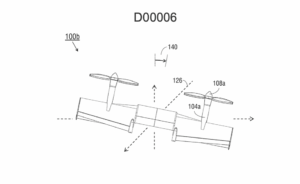
By DRONELIFE Staff Contributor Jim Magill
As the deadly global coronavirus pandemic enters its second year, drone technology companies around the world are racing to develop new applications to not only prevent the spread of the virus but to deliver life-saving vaccines and other medical supplies to remote areas.
Draganfly, a more than two-decade-old drone developer, which already has contributed a great deal in the fight against the virus, is developing another weapon in the fight against COVID-19 and other diseases. The Raleigh, North Carolina-based company, which has developed camera-based technology to remotely assess a person’s state of health, as well as disinfectant-spraying drone systems that can make sports stadiums safe for fans, currently is developing an unmanned aerial system to deliver vaccines to hard-to-reach places such as offshore oil rigs.
In December, Draganfly Inc. announced it had been selected by Spring Branch, Texas-based Coldchain Technology Services, a leading healthcare supply chain management company, “to immediately develop and provide flight services of a robust vaccine-delivery payload for use in critical regions for drone delivery of the COVID-19 vaccine.”
Coldchain, one of the largest vaccine distributors in the United States, has contracts to deliver vaccines in 15 states, and is the exclusive COVID vaccine distributor for the state of Texas.
“We are building out for them a drone delivery service that will be able to supply vaccines and medical supplies into challenged locations, like offshore rigs, disaster areas or other remote locations,” Cameron Chell, Draganfly’s CEO, said in an interview.
Draganfly is developing a payload container, equipped with a sustainable thermal-management system with the capability to carry a minimum of 300 multi-doses or 100 single doses of the vaccine. The payload will comprise a crucial part of a comprehensive delivery and logistics platform that Draganfly will operate.
Draganfly’s COVID-19 Delivery System: The Platypus

The Platypus “includes forward, and aft wing assemblies mounted to the fuselage, each wing assembly including port and starboard nacelles terminating in motor-driven rotors powered by an onboard control system capable of adjusting rotor speeds,” according to Draganfly’s recent announcement. The vehicle’s design makes it capable of performing flights beyond the visual line of sight (BVLOS) as well as flights over people and at night, Draganfly said.
Wayne Williams, executive director of Coldchain Technology Services, said the new delivery system would allow drones to deliver vaccines and other medical supplies to hard-to-service locations, such as offshore drilling platforms.
“They have people on the ground that are trained as EMTs, so they can do the basic medical care like give a shot or draw blood, but it was still costing a lot to put the product out there,” Williams said. “Right now, we have one organization that flies it out on a helicopter. You can imagine what the hourly rotor time for a helicopter is versus the hourly rotor time for a drone.”
More of Draganfly’s COVID-19 Tools
The development of the drone vaccine-delivery system marks Draganfly’s most recent effort to contribute to the battle against the coronavirus, Chell said. The company also has used its drones to spray disinfectant to make sports facilities safe for fans in the state of Alabama.
In December, Alabama State University said it had entered into a deal for Draganfly to employ its drones to spray its patented pathogen and virus sanitizer, Varigard, at the school’s football venue, ASU Stadium, and the Dunn-Oliver Acadome, the school’s basketball arena.
“They were able to open this basketball season this January, thanks in part to using this spray, which protected the seating area, the locker room and everything else,” Chell said.
Although Draganfly currently uses pilot-controlled drones, “in time we’ll also be able to do it autonomously as well as providing the facilities we work in with a digital twin of their facility,” he said. “That’s a pretty good innovation in terms of doing non-GPS flights. That’s where the business is going.”
In addition to developing drone-based solutions to prevent the spread of disease, Draganfly also has developed other technological applications to help detect potential signs of the virus as well.
Recently, a customer asked Draganfly to develop a drone-borne camera system to detect levels of mask wearing and social distancing within crowds. “We delivered that system — the drone could detect social distancing and mask wearing — and then they made a funny comment, ‘Could you build something to detect COVID-19?’.”
Although the comment was made half-jokingly Draganfly’s developers took the challenge seriously. “We said, ‘We don’t think we can detect COVID 19, but we think we can detect infectious conditions,” Chell said.
“Fast-forward 10 months later and we commercially deployed a software that can be used with pretty much any camera — on a drone, a kiosk, a laptop, a smart phone or a security system,” he said. “The camera can detect your heart rate, your respiratory rate, blood pressure, your blood oxygen level and your BMI, body mass index.”
Last month, the Alabama State Senate announced it had adopted the Draganfly Smart Vital System, to test people at risk of infection, allowing the state to minimize the spread of coronavirus in government buildings.
Miriam McNabb is the Editor-in-Chief of DRONELIFE and CEO of JobForDrones, a professional drone services marketplace, and a fascinated observer of the emerging drone industry and the regulatory environment for drones. Miriam has penned over 3,000 articles focused on the commercial drone space and is an international speaker and recognized figure in the industry. Miriam has a degree from the University of Chicago and over 20 years of experience in high tech sales and marketing for new technologies.
For drone industry consulting or writing, Email Miriam.
TWITTER:@spaldingbarker
Subscribe to DroneLife here.